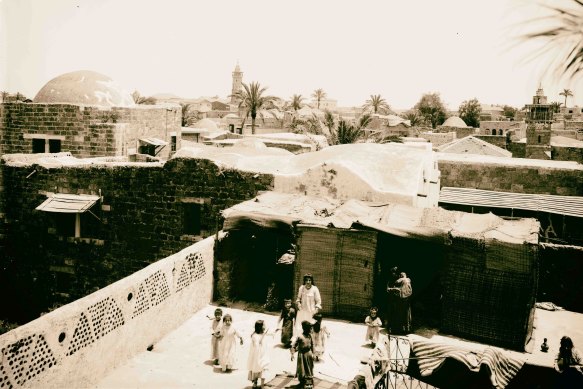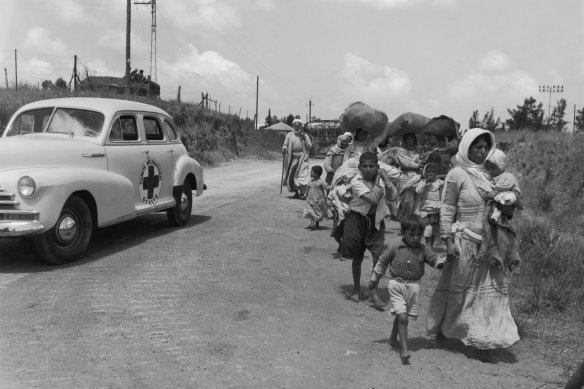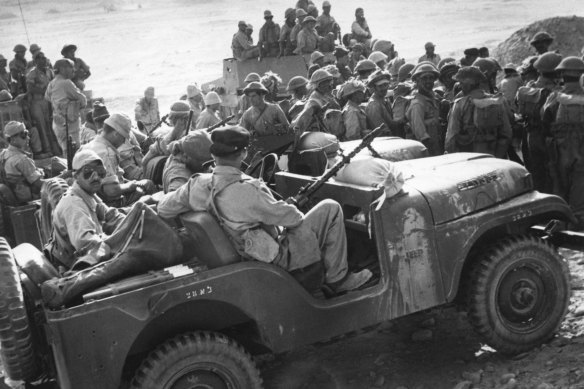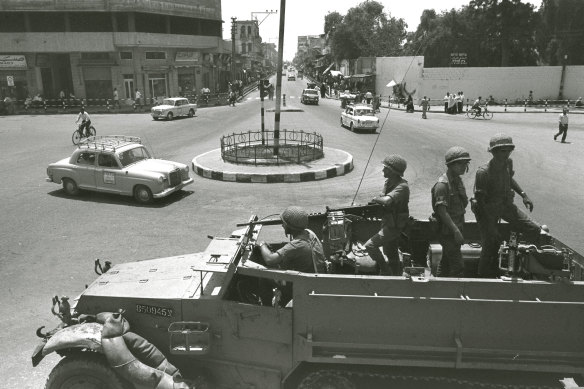Once a trading hub, Gaza has been controlled by various powers in the past century. Who lives there now? And what is the history of the Gaza Strip?
Save articles for later
Add articles to your saved list and come back to them any time.
A tiny scrap of land wedged between Israel, Egypt and the Mediterranean Sea, the Gaza Strip has been a military and political flashpoint for much of its history.
In the past 100 years alone the ancient city of Gaza and its surrounds have been ruled by the Ottoman Empire, Britain, Egypt and Israel. Home to some 2 million Palestinians, many of them refugees, it’s one of the world’s most densely populated areas. It is now self-governed by the Islamist militant group Hamas, designated a terrorist organisation by several countries, which has launched a brutal attack on Israel in recent days.
How did today’s Gaza Strip come into being? And why has it been controversial?
The city of Gaza in 1898.Credit: Getty Images
What’s the Gaza Strip and who lives there?
The town of Gaza dates back to ancient times, controlled for a period by the Romans. Gaza’s port was once a busy trading hub, but the history of the modern enclave called the Gaza Strip dates back to 1947.
That was when the United Nations approved a plan to partition the region, then occupied by the British and known as Mandatory Palestine (because the British had been granted a mandate by the League of Nations to administer it) into separate Jewish and Arab states, in the wake of World War II and the Holocaust.
Palestinian Arabs were allotted the town of Gaza and surrounding areas, along with a larger territory surrounding Jerusalem, part of which forms the West Bank today. The following year, when Britain ceded control of the region, the newly formed state of Israel accepted the UN’s boundaries but the Arabs did not.
On May 15, 1948, the day after Britain’s official departure, war broke out between Israel and Arab countries including Syria, Lebanon, Jordan and Egypt. The town of Gaza became strategically important to Egyptian forces as they moved north after their assault bogged down nearby, says Dr Ran Porat, an analyst on Israel and Middle Eastern Affairs at Monash University. “The Egyptian Army had orders to conquer Israel through the coastline,” he says, but stopped north of Gaza, facing Israeli resistance. That left the Egyptian forces controlling a strip of land some 40 kilometres long and between six and eight kilometres wide.
When Egypt and Israel agreed to cease hostilities and drew up an armistice agreement on February 24, 1949, the territory’s boundaries were formally drawn up into the region that we know today as the Gaza Strip, with the city of Gaza towards its northern border.
The first Arab-Israeli War displaced between 700,000 and 800,000 Palestinians, many of whom ended up in the Gaza Strip. “This is how the Gaza Strip, basically, was created,” says Dr Anas Iqtait, a lecturer at ANU’s Centre for Arab and Islamic Studies. “The war of 1948 resulted in pushing the Palestinians to these borders.”
Today, there are eight official refugee camps within Gaza accommodating more than 600,000 people. Some of the camps were set up to house Palestinians fleeing the first Arab-Israeli war. About 81 per cent of the population lives in poverty and the unemployment rate is nearly half, says the United Nations Relief and Works Agency for Palestine Refugees, which provides services for refugees in Gaza. Around 1 million people rely on daily food aid.
Arab civilians, helped by the Red Cross, move out of the Jewish sector of Jerusalem c 1948.Credit: Getty Images
When did Israel first occupy the Gaza Strip?
Gaza remained under Egyptian military rule until the Suez Crisis of 1956 when, once again, its geography proved significant. That was when Egypt, under president Gamal Abdel Nasser, nationalised the Suez Canal Company, giving it the power to control the passage of vessels through the region.
In response, Israel, alongside paratroopers from France and Britain, attempted to wrest control of the canal back from Egypt, with the Gaza Strip a key target in its efforts to encircle Egyptian forces and to prevent subsequent retaliatory strikes.
“Nationalisation of the canal was very alarming to the European powers,” says the University of Melbourne’s Dr Simon Frankel Pratt. “So a kind of agreement or pact emerged between Great Britain, France and Israel. The United States disapproved significantly of this plan and prevented it coming to full fruition, but it did lead to a war.” Israel subsequently occupied the Gaza Strip for several months before relinquishing it to Egypt, who remained in charge for the next decade.
Israeli troops in the Sinai Desert after capturing the Gaza Strip during the Suez Crisis of 1956. Credit: Getty Images
When was Hamas formed?
By 1967, Israel, surrounded by hostile Arab states that potentially threatened its existence, had acquired a large and well-trained army. After a series of minor skirmishes with its neighbours, who appeared to be mobilising for full-scale war, on the morning of June 5, Israel struck first.
Within hours, it had wiped out most of the Egyptian, Jordanian and Syrian air forces, leaving their ground troops vulnerable. Over the next five days, Israeli forces captured the Gaza Strip and the Sinai Peninsula from Egypt, the Golan Heights from Syria and the West Bank and East Jerusalem from Jordan, with Arab casualties and equipment losses vastly outnumbering those of Israel. A ceasefire was agreed on June 10.
The Six Day War left more than 1 million Arab refugees under Israeli rule, strengthening support for the Palestinian Liberation Organisation. “Palestinians were becoming more and more aware they were going to have to do more of their liberating themselves, that they couldn’t rely on the Arab states,” says Ian Parmeter, research scholar at the Centre for Arab and Islamic Studies at ANU.
The region remained unstable: significant conflicts include the Yom Kippur war of 1973, when Egypt and Syria surprised Israeli forces, and the populist uprisings known as the intifadas of 1987 and 2000, when Palestinians living in the West Bank and Gaza staged a series of protests and riots against Israeli rule. “It was soon after the start of the First Intifada in 1987 that Hamas was formed in Gaza,” says Parmeter. “Hamas was an offshoot of the Egyptian Muslim Brotherhood … and was formed in Gaza because there were strong connections at that stage between Gaza and Egypt.”
In the 1990s, the Palestinian Liberation Organization and Israel struck agreements in Washington DC and Egypt called the Oslo Accords, outlining a peace process that recognised Palestinians’ right to self-determination.
The PLO formally agreed to give up resistance through violent means as a method for establishing a Palestinian state or for liberation. The accords led in 1994 to the creation of the Palestinian National Authority.
An Israeli army patrol passes through Gaza’s main square in 1969, two years after the Six Day War.Credit: Getty Images
Who controls the Gaza Strip today?
Palestinian National Authority president Yasser Arafat died in 2004, a political figure who historians now consider came closest to uniting the Palestinian cause. In 2005, Israel withdrew its military and settlers from the Gaza Strip for security and political reasons amid little prospect of wider peace negotiations. “It was labelled the ‘hornet’s nest’,” says Porat. “A hotbed of extremist ideologies because of poverty and a fundamentalist point of view”. Gaza remained dependent on Israel for its water, electricity and telecommunications, and Israel also controlled its air and maritime spaces.
In 2006, the militant organisation Hamas defeated Fatah in a democratic election after a campaign that argued the Oslo Accords had failed. However, Hamas regarded some opponents as a continuing threat. “As a result, [Hamas] launched a pre-emptive campaign in the Gaza Strip in order to eliminate the Palestinian security forces who, according to Hamas, were disloyal to the government,” Iqtait says. “It resulted in the complete takeover of the Gaza Strip, both politically and in terms of security.”
Hamas and other militant groups have continued to clash with Israel in the years since, with sporadic rocket attacks emerging as a threat to Israeli citizens within range of the Gaza Strip. In 2021, militants fired more than 4000 projectiles into Israel over 11 days, killing 10 Israeli civilians and injuring more than 300 others. Retaliatory Israeli air strikes killed more than 200 Palestinian civilians.
The rocket threat led Israel to invest heavily in its “Iron Dome” defence system. It has also increasingly fortified the physical cordon around the Gaza Strip, including building underground barricades to prevent militants tunnelling underneath, which was nonetheless breached in the recent attacks.
Get fascinating insights and explanations on the world’s most perplexing topics. Sign up for our weekly Explainer newsletter.
If you'd like some expert background on an issue or a news event, drop us a line at [email protected] or [email protected]. Read more explainers here.
Most Viewed in World
Source: Read Full Article









